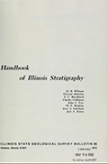Historical:Spoon Formation
Lithostratigraphy: Kewanee Group >>Spoon Formation
Chronostratigraphy: Paleozoic Erathem >>Pennsylvanian Subsystem >>Desmoinesian Series
Allostratigraphy: Absaroka Sequence
Authors
M. E. Hopkins and J. A. Simon
Name Origin
The Spoon Formation of the Kewanee Group (Kosanke et al., 1960, p. 32, 45) is named for the Spoon River, Fulton County.
Type Section
The type section, which is in a roadcut and a railroad cut (NE SE 22, 6N-1E), is about a quarter mile west of the Spoon River.
Correlation
The Spoon Formation correlates with the upper part of the Tradewater Formation and the lower part of the Carbondale Formation in western Kentucky and the very uppermost part of the Brazil Formation, all the Staunton Formation, and the lower part of the Linton Formation in Indiana.
Extent and Thickness
The Spoon Formation is present throughout most of the area in which Pennsylvanian strata occur. It is as much as 350 feet thick in southern Illinois but ranges from a few feet to less than 100 feet in northern and western Illinois.
Stratigraphic Position
The formation consists of strata from the top of the Bernadotte Sandstone of western Illinois or the Murray Bluff Sandstone of southern Illinois to the base of the Colchester (No. 2) Coal (fig. P-2), rocks formerly included in the upper part of the Tradewater Group.
Description
The formation is characterized by less sandstone and more coal and limestone than the Abbott Formation below and by less limestone and coal than the Carbondale Formation above. Sandstones are well developed in both elongate and sheet facies but do not constitute as much of the total section as they do in the lower formations. The sandstones show the general upward increase in the amount of argillaceous matrix and mica flakes that began in the sandstones in the Abbott Formation, from which they differ only slightly. The formation contains the first widespread limestones and coals, but they are thinner than those in the younger Pennsylvanian of Illinois. The coals of the Spoon are thicker and more extensive than those of the lower formations.
References
KOSANKE, R. M., J. A. SIMON, H. R. WANLESS, and H. B. WILLMAN, 1960, Classification of the Pennsylvanian strata of Illinois: Illinois State Geological Survey Report of Investigations 214, 84 p.
ISGS Codes
| Stratigraphic Code | Geo Unit Designation |
|---|---|

